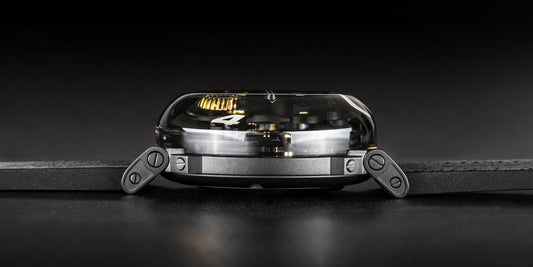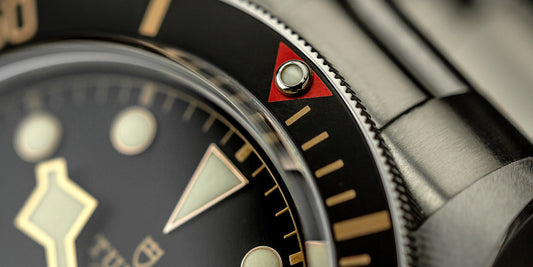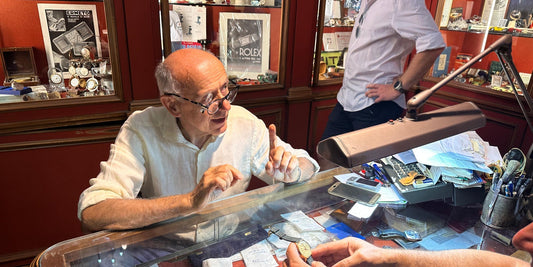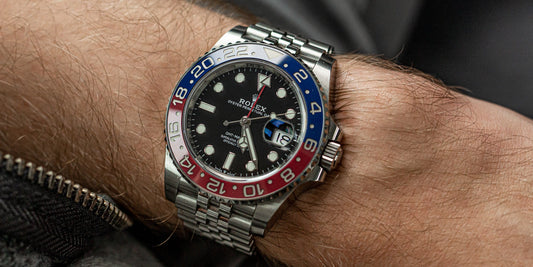Racing watches, or motorsport watches, grew as an evolution of the pocket stopwatches that were originally used to time motorsport events in the early days, and then as an extension of the in-car clocks that were competition as outright speed. As cars became more sophisticated, the need for accurate timing became more acute. Prince Scipione Borghese won the 1907 Peking to Paris road race with a winning margin of 20 days. essential equipment on rally cars in particular – where regularity and sticking to time was as much a part of the closest-ever grand prix finish, by contrast, was 0.01 seconds.
So as the decades rolled by, the desire for reliable, personal timekeeping culminated in the development of wristwatches often worn by racing drivers. Jack Heuer led the way by sponsoring several top Formula 1 stars in the late 1960s: they were even on commission if they managed to sell watches to their colleagues!
By the 1970s, the watch scene had well and truly taken hold of global motorsport: Steve McQueen’s distinctive Heuer Monaco became an icon of the Le Mans movie in 1971, for example. Since then, timing in motorsport has become increasingly sophisticated and computerised, but the legacy of watch companies in motorsport still lives on through lucrative sponsorship deals and brand ambassador contracts – used to help sell the racing watches we wear every day.
What makes a Racing Watch?
These days, the definition of a racing watch can be a bit fluid, as it’s more about a certain look and feels than specific technical characteristics. However, in the past, it’s often centred around the chronograph (with easily-operated pushers): an essential element when it comes to timing a lap. Contrast and legibility is also vital ingredient; one reason why ‘panda’ dials are a hallmark of racing watches. The ‘rally’ watch strap, with holes punched through the material to keep drivers’ wrists cool, is another tell-tale sign of a racing watch.
Autodromo Group B Series 2 Safari

Autodromo Group B Series 2 Safari - Credit MediaWorld
As the name suggests, Autodromo is a company that’s dedicated to motorsport watches. Although it’s relatively new, the American firm has already made a big impact on the genre with its range of innovative racing watches that are nonetheless rooted in tradition – and with a decent level of quality as well. The ‘Safari’ watch is part of the company’s Group B collection – dedicated to the heyday of classic rallying – and it’s that very unusual beast: an integrated steel sports watch that is entirely green. The result is a racing watch like no other, as redolent of the 1980s as the Rubik’s cube and Madonna. There’s a great inspiration behind it too: the Safari Rally, based in East Africa, was first run in 1953 and is perhaps the hardest international rally of them all, running over rutted roads through lush and exotic countryside. This untrammelled spirit is reflected in the plant green colours of this watch, with a dial that looks just like a Lancia speedometer from the 1980s.
Conclusion
This watch is out of production now so you’ll have to hunt one down on various auction sites but that should be very feasible within our £2000 budget; don’t expect to pay any more than £1000 for a used example. For that, you get a lot of watch for the money: a titanium and steel case, with integrated steel bracelet and bags of character, housing a reliable Miyota movement. The Group B series turned out to be a huge hit for Autodromo, but this variant (first seen in 2020) is definitely the most special one, and – just like many cars of the 1980s – it might even turn out to be a future classic.
The racing watch scene tends to be dominated by exactly the sort of classics that you would expect: namely the Rolex Daytona, Omega Speedmaster (which had its roots in car racing long before anyone went to the moon) and Heuer Monaco – or, my personal favourite, the Heuer Autavia. The problem is that all these watches well and truly bust our £2000 ceiling: so you have to think a bit more creatively. This is exactly what the team at Forzo did when they designed the Enduratimer – and I know this for an absolute fact as I was part of that team. The result is a watch that incorporates a few diverse elements of all these classics, but still maintains its own distinct character, within an attractive and cohesive package. The three-dial chronograph look holds a timeless appeal and the colours are inspired by classic liveries, such as British Racing Green and French blue, as well as the ubiquitous black and white panda. Reliability is ensured thanks to the Seiko meca-quartz movement, and at less than £600, these watches represent stunning value.
 Forzo Enduratimer - Credit WatchGecko
Forzo Enduratimer - Credit WatchGecko
Conclusion
For me, authenticity is at the heart of the Enduratimer’s appeal. We spent months researching all the racing chronographs of the 1960s and associated period colours, along with who wore them and when. The result is a really accurate reflection of how a racing watch designed during the golden age of motorsport would look if it were new right now. And it’s not just talk either, as Forzo was actually a partner of the Glickenhaus team at the Le Mans 24 Hours, the world’s most famous endurance race, ending up on the podium last year. This is a beautiful and very genuine racing watch, with its own unimpeachable home-grown pedigree.
 Forzo Enduratimer - Credit WatchGecko
Forzo Enduratimer - Credit WatchGecko
Yema Speedgraf
Yema is the most famous racing watch company that you might never have really considered. Their watches were seen on the wrists of great champions such as Mario Andretti – who still owns his example today, which he bought many moons ago with his own money – and has a history in motorsport that goes back for more than 50 years. The Speedgraf has a classic 39mm bicompax layout, with a seconds and minutes subregister, plus all the requisite tachymeter and telemeter scales that give it the archetypal vintage racing look. Paired with a rally strap, this is a watch that emphatically screams motorsport, and while it has all the heritage of its illustrious forebears, it’s still affordable enough to come in under our budget. Like the Forzo, it uses a Seiko movement, and also has the typical domed crystal that lends it the correct period vibe.
 Yema Speedgraf - Credit Yema
Yema Speedgraf - Credit Yema
Conclusion
The Yema has it all and it’s probably the most classical watch of all our choices here – which might be enough to persuade most people. Yema themselves call it a “competitively priced neo-vintage chronograph” and that’s a great summary. But the truth is that it’s much more than that: a truly holistic watch that genuinely captures what the racing genre is all about. You could have this as your only watch and be very happy.
 Yema Speedgraf - Credit Yema
Yema Speedgraf - Credit Yema
Tissot PRX chronograph
The Tissot PRX was a bit of a game-changer when it was relaunched back in 2020; a watch that came equipped with a Swiss pedigree, retro-cool 1980s styling, and a compelling value proposition. Following the original three-hand watch, the revived 42mm chronograph emerged later – and with it the embodiment of what a racing watch with timing function from the 1980s would have looked like (although Tissot’s case shape is technically from the 1970s, having made its debut in 1978). Aesthetically, it’s an absolute stunner with three Paul Newman-style contrasting subdials and an integrated bracelet, while technically the Valjoux movement is a class-leader that needs no further introduction (you can get to know it better through the display case back). The only issue is getting hold of this watch; it’s proved so popular that you might need to hunt around for a little while, especially if you want the stunning white and blue version.

Tissot PRX - Credit Tissot
Conclusion
Tissot was well-known as a timing partner of Formula 1 in the 1980s, and that influence has definitely rubbed off on me subliminally as this just feels like an achingly cool grand prix watch that would be at home in Monaco. There’s not much more that can be said about the game-changing steel PRX that hasn’t been said already, but it’s been undervalued as a racing watch, so it makes a worthy appearance here. The design is sleek yet retro with its flat chronograph pushers, and it still feels contemporary now. You’ll need most of our £2000 budget to buy it, but it’s worth the money. I tried one on in Switzerland recently and regretted not making a purchase; despite its size it was surprisingly svelte on the wrist, gorgeous to look at, and so comfortable to wear.
Hamilton Intra-Matic Auto Chrono

Hamilton Intra-Matic Auto Chrono - Credit MediaWorld
“Buy the best watch you can afford” was sage advice that I was given a long time ago, and in that spirit we’re including this spectacular Hamilton priced at £2085: £85 over our putative budget. But show me a watch dealer who won’t do a deal – so we’re confident that it can still be secured on budget. For that, you get a wonderful historic revival, as this 40mm watch is a copy of a model that originally came out in 1968. It also apparently featured in The Matrix Resurrections (2021), which is equally cool but in a very different way. This classic black and white watch with an H-31 hand-wound automatic movement gives you a 60-hour power reserve. With its prominent chronograph pushers, it’s the perfect marriage of form and function: you can imagine using it to time cars racing past you at Daytona Raceway back in the day (without a Rolex in sight). It has genuine heritage as well, because the original 1968 Chrono-Matic was one of the very first automatic chronographs in the world, alongside those made by Heuer and Breitling. Distinguished company indeed.
 Hamilton Intra-Matic Auto Chrono - Credit MediaWorld
Hamilton Intra-Matic Auto Chrono - Credit MediaWorld
Conclusion
The fact that Hamilton is becoming a regular fixture in our ‘Top 5’ lists shows how under-rated this originally-American brand is (although it’s been Swiss since 1969, and now forms part of the monolithic Swatch Group). Nonetheless, Hamilton has done an incredibly good job of hanging onto its history and offering people watches that are technically and stylistically spot on, at a decent price. Not everyone will enjoy the uncompromising authenticity: this watch has a lot of thickness, just as was the case in the 1960s. But as a racing watch that will truly turn heads and reflect tradition, it’s hard to think of a better alternative at this price point.
















